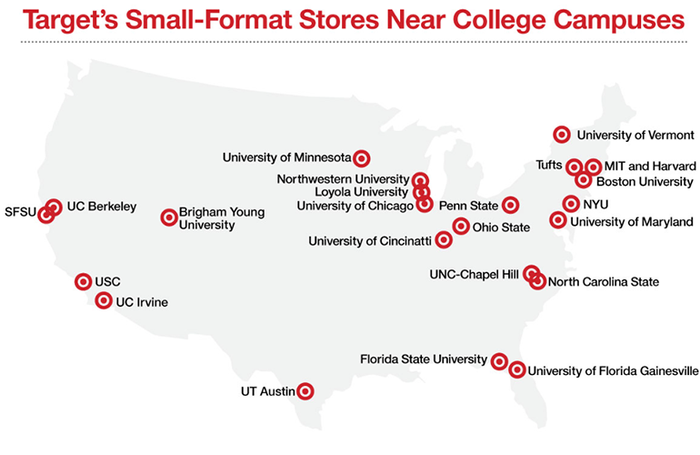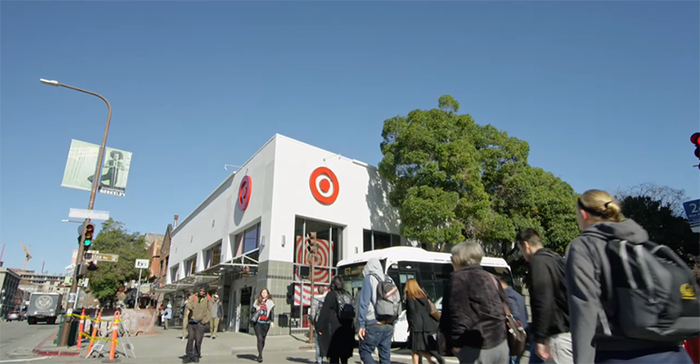Target readies more college campus storesTarget readies more college campus stores
Food tops list of student purchases at small-format locations
Target Corp. plans to open three more small-format stores on or near university campuses to meet the food and daily essentials needs of on-the-go college students.
Slated to open their doors this fall, Target said, are a 20,000-square-foot store on the University of Kentucky campus in Lexington, Ky.; a 22,000-square-foot store on the Michigan State University campus in East Lansing, Mich.; and a 21,000-square-foot store near the University of Washington in Seattle.
Currently, Target operates 23 small-format stores on or near college campuses in 13 states, including 10 locations opened last year.

“Going off to college is a new life stage. Students are making their own shopping decisions for the first time,” according to Mark Schindele, senior vice president of Target Properties. “We want to help make students’ experiences fun and easy, serve up products and services they’ll love and show them the best that Target has to offer so they become lifelong guests.”
Designed for quick shopping trips, the college stores are stocked with locally relevant products at affordable prices, Target said, adding that these outlets also provide a convenient pickup site for Target.com orders. The Minneapolis-based retailer noted that each new store offers a specially curated product assortment and shopping experience for the students, university staff and local professionals and residents of the surrounding community.
Heading the list of student needs is food, led by grab-and-go lunch and snack items such as bananas, sandwich bread, Greek yogurt and apples, Target reported. Other high-demand items include personal-care products like toothpaste, toothbrushes and body wash, as well as dorm décor and apparel and school supplies and tech accessories such as notebooks, headphones, batteries and cell phone adapters. Target said students also are drawn to the store for the retailer’s exclusive brands, including Room Essentials home products and Heyday tech accessories.
“While all Target store teams strive to learn what local guests need and adapt accordingly, it’s particularly important for small-format stores near college campuses to get to know the unique needs of our student guests,” explained Scott Timpani, store team leader at Target’s University of California-Irvine location. “For example, during the school year, about 10,000 students each day cross a pedestrian bridge that starts on campus and ends a few steps from our back entrance. Knowing these guests are often heading to class or simply in a hurry, we have four self-checkout kiosks next to the doors so they can quickly complete purchases and be on their way. And for guests who have more time to spend, we’ve created a cozy seating area near Starbucks complete with outlets for charging their devices.”
 Small-format stores are a linchpin of Target’s expansion strategy. Aiming at sites ranging from urban neighborhoods to college campuses, the retailer said it’s looking to open about 30 of the small stores annually over the next several years.
Small-format stores are a linchpin of Target’s expansion strategy. Aiming at sites ranging from urban neighborhoods to college campuses, the retailer said it’s looking to open about 30 of the small stores annually over the next several years.
“Today, we have almost 100 small-format stores, and they are highly productive,” Chairman and CEO Brian Cornell told analysts in a call on Target’s fiscal 2018 results. “Herald Square, just down 6th Avenue [in Manhattan], does more sales per square foot than any other store of any size in the company, and we'll continue opening a couple of dozen new-format stores each year in cities and on college campuses across the country.”
During fiscal 2018, Target opened over 1 million square feet selling space in small-format stores, including in large markets like New York and new markets like Vermont, according to Chief Operating Officer John Mulligan.
“In fact, some of our most recent openings have already become our highest-volume small-format stores, even as the traffic in our mature small formats has continued to rise. This year, we'll open doors in growth areas like L.A. and Washington, D.C., near college campuses in Seattle and East Lansing and also in new communities for Target like Cape Cod [Mass.] and Santa Barbara [Calif.],” Mulligan said in the earnings call. “These stores help us enter new neighborhoods, where a full-size store wouldn't fit and where we see a need we can fill. And they continue to show strong financial performance, beating our chain average of comparable sales growth and productivity.”
About the Author
You May Also Like





.webp?width=300&auto=webp&quality=80&disable=upscale)
